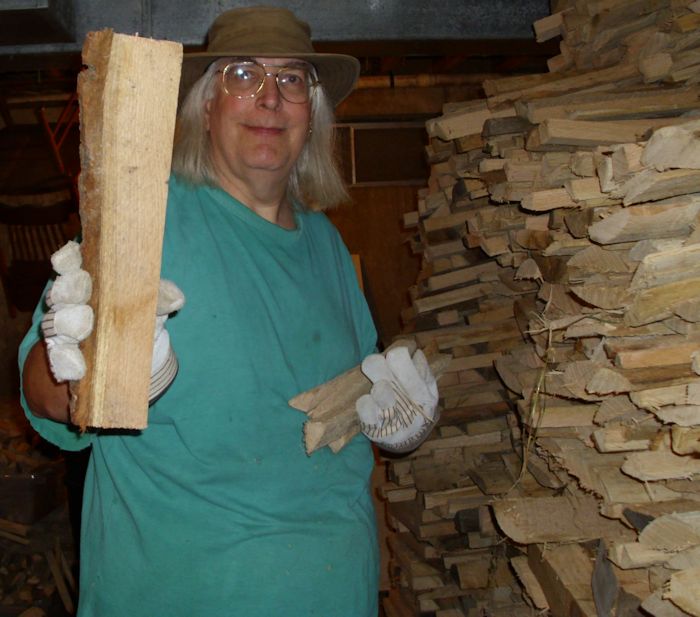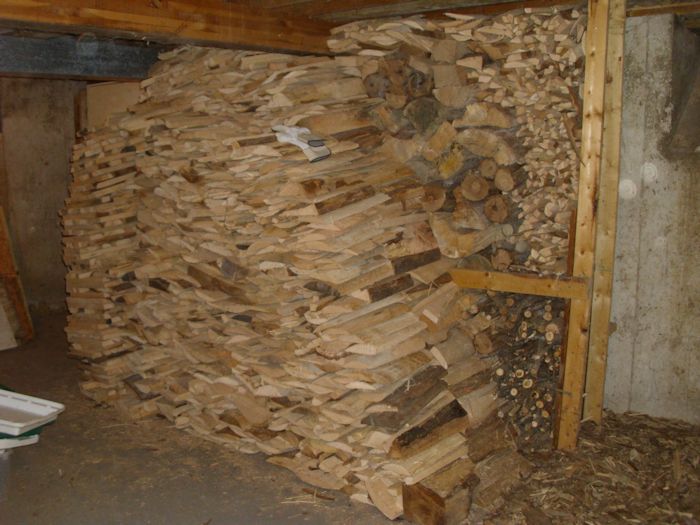It’s that time of year again-time to get the wood ready for winter. Of course, cutting, splitting, and stacking wood warms you twice: once when you do it and again when you burn it. With our weather being so beautiful, I really did get quite warm over the last couple of weeks getting my wood ready. It is definitely easier if you use quality wood axes, though, and now the piles are finally finished. I have a little over two cords of wood outside and four cords in the basement. I’ll eventually bring the outside stack up to three cords.
As I mentioned in The Many Appearances of Firewood, I use three different cuts of wood for my pile: slab, log, and disk. Each kind of wood has its own advantages. For example, it’s extremely easy to get slab wood started as long as it isn’t wet. In addition, I buy slab wood, rather than cut it, so the slab wood is less work because I only have to stack it. Logs, the traditional firewood, are easy to stack and burn at a moderate rate, which makes them a good option for maintaining a fire. Using disks has the advantage of a slow, long lasting burn of larger pieces without having to split them. I generally put a disk in the wood stove before I start it up in the morning to keep the fire burning at a nearly even temperature. Larger disks are hard to add later, but you can easily add smaller disks to a wood stove.
Of course, there is the question of what precisely a cord is. A full cord is always 4 feet deep, 4 feet high, and 8 feet long (128 cubic feet). I generally cut my logs 2 feet long, so my cords are usually some combination of dimensions that add up to 128 cubic feet. For example, my outside stack is 2 feet deep, 4.5 feet high (actually, a little higher), and 14 feet long. The stack in my basement is 2 feet deep, 8 feet high, and 8 feet long. Any set of dimensions that adds up to 128 cubit feet is one cord. Purists will insist on the standard measurement, but really, the wood doesn’t care how its organized.
Ask specific questions when you buy wood. Some sellers will try to tell you that they’re selling you a cord of wood when you’re really getting a face cord, which doesn’t have a precise size. Most face cords are one-third to one-half the size of a full cord. The pieces of wood are sometimes only 16 inches long to accommodate smaller wood stoves and fireplaces. You need to ask how much you’re getting when comparing prices between sellers. If a seller won’t tell you how much wood is in a load, it’s probably a good idea to go somewhere else.
Beware of the fluffy load. Someone will drive up with what looks like a full load of wood, but the wood is ill stacked with a lot of air gaps in it. A poorly stacked load won’t contain as much wood as you might think it will. Another trick that some wood cutters use is to include a lot of smaller pieces that tend to add air gaps and don’t burn very well. You can obtain your own kindling with relative easy, so look for sellers who provide larger pieces of wood in a well-stacked form so that you know the amount you’re actually getting.
When I cut wood, I know precisely what kind I’m getting. This year I’ll be burning a combination of American oak and white elm. There is a little maple and black locust mixed in, but the majority of the wood is oak and elm. The wood you get determines how much heat you get. After you find out what kind of wood you’re getting for your stove, make sure you consult a wood heating chart. A load of wood with great burning characteristics may actually be a better deal, even if it costs more, because you get more heat from it. As an example, let’s say that one seller offers you a cord of white oak at $120, while another seller offers you a cord of birch at $100. The white oak is a better deal because it only costs $4.124 per million BTU (120 / 29.1 million BTU), compared to $4.808 per million BTU for the birch (100 / 20.8 million BTU). You also want to verify that the wood is actually dry (some people will try to sell you green wood, which won’t burn well).
Some people neglect to factor in the amount of smoke and ash that the wood creates. Of the two, the amount of smoke is the most important factor because you have to call a chimney sweep if your chimney gets clogged by wood that produces too much smoke. This kind of hassle often leads people to make the decision to have central heating installed, from a site similar to this one, rather than having to buy and chop firewood. However, I think a wood-burning stove creates a kind of homely atmosphere you can’t replace with a heating system. The ash is an annoyance, but you can always clean the ash out of the wood stove as needed. Even so, getting wood that produces less ash means less ash for you to clean up later. Let me know your thoughts about getting your winter wood supply together at [email protected].


